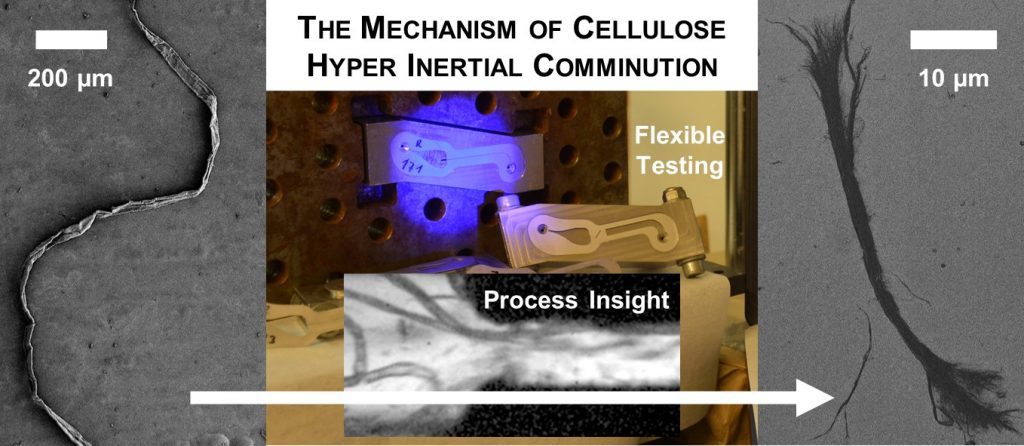Wood hemicelluloses: molecular structure and interactions in plant cell walls
Wood is a formidable composite material with unique biological functions (as secondary plant cell wall) and outstanding properties to be exploited in material applications. Hemicelluloses act as the molecular connection, interacting with cellulose microfibrils and lignins, contributing to wood integrity (biological function) but also to recalcitrance (technical challenge). The dynamics of hemicelluloses in hydrated form […]
Study of the multiscale networks of hemicellulose hydrogels by scattering techniques
The aim of the project is to develop multifunctional soft materials (hydrogels) from hemicelluloses for biomedical and food applications. We combine chemo-enzymatic methods to modify the molecular structure of the hemicelluloses and to tailor their assembly and rheological properties. In this project we want to understand the assembly mechanisms that drive the gel formation upon […]
Processability of modified fibres for complex shaped parts
There is a drive towards the use of single-component materials in different applications, for example in opening and closure of packaging products and in single use plastics (SUP). This opens up the possible use of cellulose-based products, but increases the demand for new modification strategies for fibres. Modifications aiming at improving their processability and final […]
Multifunctional fibres for different end-use applications
During the last decade there has been a large focus on using wood-based fibres in new materials and there has also been an overwhelming development of the use of nanocelluloses (NCs) in new types of composites where the properties of the Cellulose NanoFibrils (CNFs) or Cellulose NanoCrystals (CNCs) are utilized to create unique material properties. […]
Low density and wet stable networks of cellulose nanofibrils with a tailored 3D shape for advanced applications
The project has the following purpose and aims: (a) Novel wet-stable, low density networks of cellulose nanofibrils (CNF) with a tailored 3D structure; (b) Tailored structures through controlled freeze-linking of the CNF followed by a formation of interpenetrated polymeric networks inside the cellulose network for controlled liquid spreading and liquid holding capacity; (c) Tailored 3D […]
Surface characterization of polymeric composites and their interaction with biological tissue
This project is dedicated to understanding the properties of polymeric networks and composites thereof. Cellulose nanofibres and other fillers are included in polymeric matrices to enhance specific properties such as adhesive, mechanical or biological. The final goal is to generate next generation tissue adhesives in which bio-based materials are used to a larger extend. The […]
Hyper Inertia Micro-Fluidization (HIMF)

Hyper Inertia Micro-Fluidization is a fibre fibrillation process design platform that shifts process understanding into the focus for process design. The goal of HIMF is to capture leading mechanism in fibre fibrillation and destruction by in-situ observation and characterization of treated fibres. An essential element of HIMF is the modular design that allows for a […]
Unbleached Kraft fibers for CNF and thermoplastic biocomposites
Unbleached Kraft fibers have been used to prepare lignin-containing CNF with interesting characteristics. The fibers and fibrils will be used in thermoplastic biocomposites, and structure-property relationships will be investigated.
New functional materials based on polysaccharides
The project is on preparing novel types of polysaccharide based materials with new functionalities. The focus is on building materials with unique structures, understanding the on structure-property relationship, and then modifying the structures in a controlled way so that the materials can be utilized in a specific application.
Macro- and microscopic deformability of fiber networks made from softwood fibres
Holmen is a major Swedish producer of paper and board products. Most of these products are based on softwood fibres. During converting of the products, they are plastically deformed in folding, creasing or embossing operations. This deformation occurs both in a macro and microscale. It is therefore important to understand the influence of the raw […]
Cavitation Fibrillation of Cellulose Fibres (CaFiCeFi)

The project is of explorative nature and aims on mapping the destructive nature of cavitation on cellulose fibres. Neither cavitation nor the dispersion of cellulose fibres in its constituents (cellulose fibrils for dissolving pulp fibres) is fully understood. The project objective is to guide whether cavitation is a mean for efficient and dedicated fibrillation at […]
Flow assisted assembly of biocomposite filaments based on Cellulose Nanofibrills (CNF)
The fundamental facet of this project is to design and fabricate functional composite filaments based on CNF and polymers. The aim is to prepare filaments with superior mechanical properties and/or advanced functions. In this project, we are going to control the interaction between individual CNFs during flow assisted assembly using different heterofunctional polymers. The project is […]

